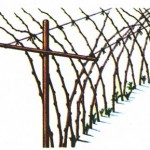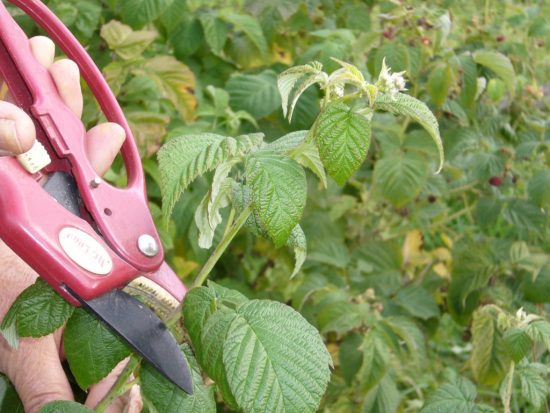Remontant raspberries can be grown for one harvest or two. Beginning gardeners are most often advised to grow raspberries for one autumn harvest. And this method really has many advantages. First of all, caring for the plantation is greatly simplified.
Pruning remontant raspberries for one harvest
The essence of the method is as follows. In late autumn, all raspberry stems are cut out. It is important to cut them down to the ground, without leaving stumps. And in this form, a completely empty bed goes into winter. Naturally, all problems with wintering disappear. In the spring, when the shoots begin to grow, only 7 - 10 of the most powerful stems are left per 1p. meter, and the rest is cut off.
During the summer, carry out normal care. Raspberries are watered, fed, mulched. You just can’t trim the tops of remontant raspberries, as you do with regular ones. The harvest begins to form at the tops of the plants. If you cut them, you will destroy part of the harvest and delay the ripening of the berries.
Remontant raspberries begin to ripen in mid or late August. Although you will get one harvest instead of two, it will usually be larger than the summer and fall harvests. In addition, the development cycle of autumn raspberries does not coincide with the development cycle of pests and, as a result, these same pests are never present on autumn raspberries.
And now we can summarize. The advantages of this method are as follows:
- makes maintenance very easy
- no problems with wintering
- There are no pests on remontant raspberries in autumn
- one autumn harvest will be more than the summer and autumn harvests combined, when grown for two harvests.
A method of pruning remontant raspberries, in which two harvests are obtained
You can grow remontant raspberries for two harvests. This method has only one advantage compared to the previous one. But it is a very big plus. Raspberries will bear fruit in your garden from the end of June until frost. Only in August there will be a break between the summer and autumn harvest. And even if this harvest is smaller, this does not mean at all that it will be small. In any case, it will definitely be enough to feast on this wonderful berry all summer and make jam from it for the winter.
The method of growing two crops is not much different from caring for ordinary raspberries. Berries ripen on the tops of young shoots in the first year. After harvesting, the tops of these shoots are cut off. And the next year the berries will ripen again on the same shoots. After harvesting, all fruit-bearing shoots must be removed immediately. By this time, the ovary will already appear on the replacement shoots. And at the end of August or beginning of September they will also produce a harvest.

Each of these two growing methods has its pros and cons. To choose the method that suits you best, you can trim part of the raspberries in one way, and part in another. And in a year everything will become clear to you.
YOU CAN ALSO READ:
Black raspberry planting and care


 (1 ratings, average: 4,00 out of 5)
(1 ratings, average: 4,00 out of 5) CUCUMBERS NEVER GET SICK, I'VE BEEN USING ONLY THIS FOR 40 YEARS! I SHARE A SECRET WITH YOU, CUCUMBERS ARE LIKE THE PICTURE!
CUCUMBERS NEVER GET SICK, I'VE BEEN USING ONLY THIS FOR 40 YEARS! I SHARE A SECRET WITH YOU, CUCUMBERS ARE LIKE THE PICTURE! You can dig a bucket of potatoes from each bush. Do you think these are fairy tales? Watch the video
You can dig a bucket of potatoes from each bush. Do you think these are fairy tales? Watch the video
 How our fellow gardeners work in Korea. There is a lot to learn and just fun to watch.
How our fellow gardeners work in Korea. There is a lot to learn and just fun to watch. Eye trainer. The author claims that with daily viewing, vision is restored. They don't charge money for views.
Eye trainer. The author claims that with daily viewing, vision is restored. They don't charge money for views. A 3-ingredient cake recipe in 30 minutes is better than Napoleon. Simple and very tasty.
A 3-ingredient cake recipe in 30 minutes is better than Napoleon. Simple and very tasty. Therapeutic exercises for cervical osteochondrosis. A complete set of exercises.
Therapeutic exercises for cervical osteochondrosis. A complete set of exercises. Which indoor plants match your zodiac sign?
Which indoor plants match your zodiac sign? What about them? Excursion to German dachas.
What about them? Excursion to German dachas.